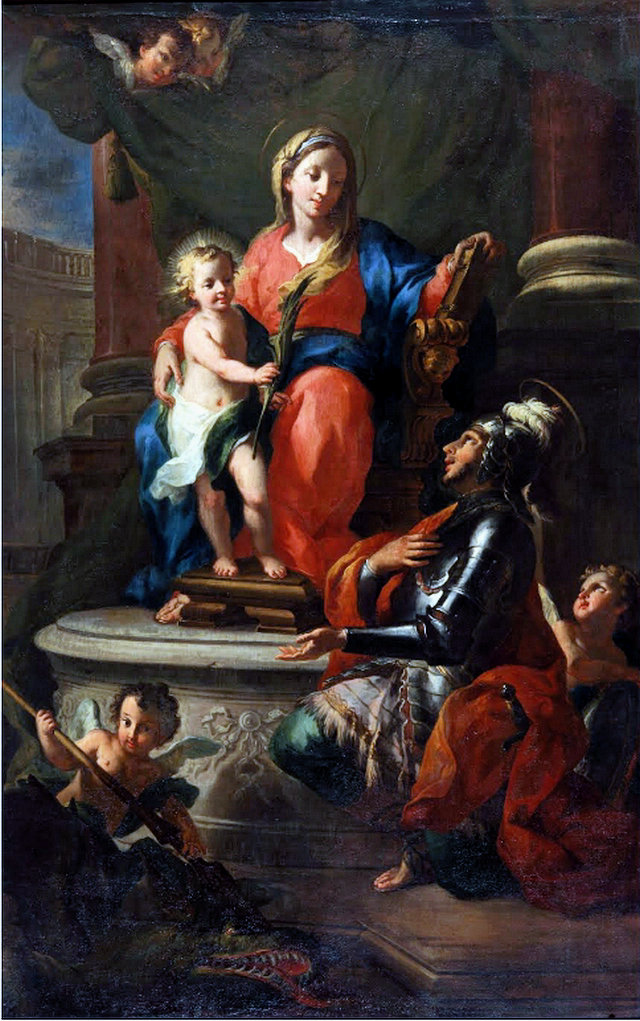Martino Altomonte


Martino Altomonte, born Johann Martin Hohenberg (8 May 1657, Naples – 14 September 1745, Vienna) was an Italian Baroque painter of Austrian descent who mainly worked in Poland and Austria.
Life and work
Martino Altomonte (Johann Martin Hohenberg) was born in a family of painters. Hohenberg’s father was born in the Tyrol and emigrated to Naples. At the age of 15 he was apprenticed to Giovanni Battista Gaulli in Rome. Later he trained under the guidance of Carlo Maratti.
In 1684 Hohenberg became the court painter of John III Sobieski, king of Poland, and changed his name to Altomonte upon the occasion. During his stay in Warsaw he mostly painted battles pieces (for example, the Siege of Vienna) and royal portraits. He also produced a lot of altarpieces, most of which did not survive. One that was not destroyed, the Sacrifice of Abraham (now Tarnów, Diocese Museum), shows Altomonte as “a follower of Neapolitan chiaroscuro painting”. His son Bartolomeo Altomonte, also a painter, was born in 1694.
Altomonte moved to Vienna c.1699-1702, where he remained for the rest of his life, creating many frescoes and altarpieces. In 1707 he was appointed a teaching member of the Akademie der Bildenden Künste that probably lead to the commission to decorate decorate the Neue Favorita, an annexe of Schloss Augarten.
The oil paintings executed during that period and that came down to us indicate that Altomonte developed his own style based on the mixture of Neapolitan and Venetian styles of painting, thus initiating Viennese Baroque painting. “In his oil paintings he scattered Venetian pastel tones among dramatic elements of Neapolitan chiaroscuro.”
In 1709-10 he worked on ceiling paintings for the archbishop’s Residenz at Salzburg. He later executed altar paintings in Vienna for the Dorotheerkirche (1713; now in Rheindorfer Parish Church), the Peterskirche and the Stephansdom (both 1714) and for the parish church in Krems and the Deutschordenskirche in Laibach (now Ljubljana, Slovenia; both 1715). In 1716 he painted the ceiling frescoes in the Lower Belvedere in Vienna.
Probably 1729 Altomonte received his workshop in the Heiligenkreuzer Hof in Vienna. In the 1830s he was close to Stift Heiligenkreuz, with whom he joined in 1738 as “familiaris”.
In the parish church Mönchhof, which belonged to the monastery Heiligenkreuz, a new high altar was built in 1736. This Gesamtkunstwerk from Kaiserstein was built by the Kaisersteinbrucher stonemason master Elias Hügel, the sculptures from Zogelsdorfer Stein are by Giovanni Giuliani and the altarpiece by Martino Altomonte.
The largest painted nativity scene of Linz is also his work. It is the altar fresco monogrammed in MA 1738. Adoration of the Infant Jesus by the Three Kings in the listed Old Catholic Prunerrolle church. The authorship by the Master was already suspected longer, the restorer but definitely confirmed until-2013.
Martino Altomonte was already 80 years old when the Abbot of Wilhering Abbey ordered the high altarpiece from him in 1737. The order was given, all pictures for the side altars were added. This altarpiece cycle was Altomonte’s last great work.
Altomonte is buried in the cemetery in Heiligenkreuz.
After his death, there were still designs for frescoes, especially in Lower and Upper Austrian monasteries, which were executed but only by his son Bartholomew.
1936 Altomontegasse in the 12th district Meidling and 23rd district Liesing was named after him.
Source from Wikipedia